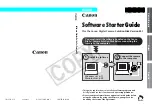
Appendix E.
Driver Disks
E.1. Why Do I Need a Driver Disk?
While the Red Hat Enterprise Linux ES installation program is loading, you may see a screen that
asks you for a driver disk. The driver disk screen is most often seen in three scenarios:
•
If you run the installation program in
expert mode
•
If you run the installation program by entering
linux dd
at the
boot:
prompt
•
If you run the installation program on a computer which does not have any PCI devices
E.1.1. So What Is a Driver Disk Anyway?
A driver disk adds support for hardware that is not otherwise supported by the installation program.
The driver disk could be produced by Red Hat, it could be a disk you make yourself from drivers
found on the Internet, or it could be a disk that a hardware vendor includes with a piece of hardware.
There is no need to use a driver disk unless you need a particular device in order to install Red Hat
Enterprise Linux ES. Driver disks are most often used for non-standard or very new CD-ROM drives,
SCSI adapters, or NICs. These are the only devices used during the installation that might require
drivers not included on the Red Hat Enterprise Linux ES CD-ROMs (or boot disk, if you created an
installation boot disk to begin the install process).
Note
If an unsupported device is not needed to install Red Hat Enterprise Linux ES on your system,
continue with the installation and add support for the new piece of hardware once the installation is
complete.
E.1.2. How Do I Obtain a Driver Disk?
The Red Hat Enterprise Linux ES CD-ROM 1 includes driver disk images (
images/drvnet.img
—
network card drivers and
images/drvblock.img
— drivers for SCSI controllers) containing many
rarely used drivers. If you suspect that your system may require one of these drivers, you should create
the driver disk before beginning your Red Hat Enterprise Linux ES installation.
Another option for finding specialized driver disk information is on Red Hat’s website at
http://www.redhat.com/support/errata under the section called
Bug Fixes
. Occasionally, popular
hardware may be made available after a release of Red Hat Enterprise Linux ES that will not work
with drivers already in the installation program or included on the driver disk images on the Red Hat
Enterprise Linux ES CD-ROM 1. In such cases, the Red Hat website may contain a link to a driver
disk image.
Summary of Contents for LINUX ES 2.1 -
Page 1: ...Red Hat Enterprise Linux ES 2 1 Red Hat Enterprise Linux ES Installation Guide...
Page 10: ......
Page 18: ...8 Chapter 1 Steps to Get You Started...
Page 72: ......
Page 74: ...64 Appendix A Removing Red Hat Enterprise Linux ES...
Page 86: ...76 Appendix C Troubleshooting Your Installation of Red Hat Enterprise Linux ES...
Page 102: ...92 Appendix D An Introduction to Disk Partitions...
Page 110: ......








































